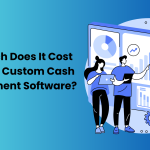Undoubtedly, this is a mobile dominant world. Still we cannot negate web apps as one of the most crucial parts of any business. Just like rainbow colors are merged into each other, web apps play an integral role to integrate various operations of a company. it ‘s how you present your goods and services to prospective clients, it’s how you grow your company, and it’s how you make an initial impression. All comes under the umbrella of web apps.
The intricate process of web application development requires careful cost analysis and budget management techniques. The cost of building a web app varies depending on a number of variables, including its kind, complexity, features, structure, and available time frame.

Furthermore, customizing a web app is a challenging task, particularly for those who lack experience in this area. By understanding our recommendations, you’ll be able to outline the features that suit your business’s web app development needs.
In this article, we’ll analyze the factors that affect the cost of web application development and provide guidelines on what to consider when estimating the cost of your project.
Let’s get down to the brass tacks – how much will web app development cost for your business?
Factors Affecting the Web App Development Cost
We have listed some of the crucial factors that influence the cost of a web app.
1: Type of Web App
One of the primary factors that you must consider influencing the cost of a web application is the kind of web application you want to build. Compared to a highly complex web app, a simple web app with fewer features will need less development budget. Moreover, different web app categories will have a different impact on the cost of web app development. For example, an E-Commerce web app, a web app for social media platforms, a CMS web app, marketplace, custom web apps – each type has different cost spectrums, which has an impact on the overall app development budget.
2: Category of Web Apps
Evaluating the cost of a web app on the basis of its category is another point of consideration. The most common web app categories include:
- Single-Page-Apps (SPAs)
A single-page web application (SPA) is a website or web app that dynamically loads on a single page without sending requests to the server again and again. Due to the fast load times, minimalistic design and lower infrastructure costs, your web app will be developed at a cheaper price tag.
- Multi-Page-Apps (MPAs)
Multi-page web apps are built using multiple pages on a website. MPAs are ideal for E-commerce stores, healthcare apps, marketplace-based web apps and educational apps. They consist of complex and large data, and need to transfer a lot of content between server and the browser. Hence, they require a high level of complexity and better UI levels compared to SPAs.
- Progressive Web Apps (PWAs)
PWAs provide the benefits of both web and mobile applications, including offline access, responsive design, push notifications and other app-like experiences. They are highly interactive and complex apps which make them expensive to develop as compared to the other two categories.
3: Features Requirements & Scope
Comparing the requirements of features for your app also decides the cost of development. Functional requirements determine what your application can do. This covers every feature, functional module, and so on. Non-functional requirements specify the functionality, scalability, and security aspects of your application.
Adding more extensive and complex requirements will increase development time and will add to the overall cost of your project.
4: Custom Designs
Without a doubt, designing a custom interface for your web application can be expensive. Therefore, selecting from a variety of pre-built themes and templates is the best option. In addition to the design process itself, searching for a custom design entails the complex coding and HTML work that goes along with it. The more custom designs you wish for your app, the higher the additional costs associated with development. When you have a good amount of money to spend, choose an advanced web application with a completely customized user interface design. That would be a plus for your business.
5: Choice of Development Partners: In-House, Freelancer Or Third-Party
How you choose your development partner highly impacts the web application development costs. Each development partner comes with its own pros and cons . Let’s discuss them one-by-one.
- In-House Development
In the in-house development model, those from your current resource pool work together to design, develop and maintain web apps. As a result of you engaging them to work under your supervision, they automatically adopt your goals, work ethics, and team dynamics. Building long-term working relationships with your in-house team allows you to use them on multiple projects. Conversely, you may have to pay higher wages and long-term benefits, which increases your expenses. When working on a web development project, using internal resources can reduce the creativity and innovation you could get from working with a different team every time. Your internal developers and project managers will also need to be upgraded if you want to handle the disparities.
- Hiring a Freelancer for Web Development
If you’re working on a small-scale web app, hiring a freelancer seems a reasonable option. An independent contractor is readily available to work on your project requirements and is usually a low-pricing solution.
A disadvantage of “Freelancers” is that they lack the resources of a larger team, which limits their potential. Building a friendly rapport with them can be challenging because they are hired on an ad hoc basis.
- Hiring a Third-Party Development Agency
If your project requirements are highly complex and time-consuming, outsourcing a third-party agency works well. An outsourcing agency will always charge you more than a freelancer but less than your in-house team. By hiring an agency, you’ll accelerate time-to-market, incorporate a high level of skills, and experiences and get a high-quality custom web application.
On the flip side, your direct control is compromised as you have less communication and onboarding about the project.
6. Count of Integrations with Third-Parties
Integrations present a chance to save money as well as incur costs. One way to maximize scope and minimize the need for custom development is to integrate third-party services and pre-made solutions for common tasks like CRM or payment features. Integration, on the other hand, may come with a subscription or licensing fee and requires support.

Wrap Up – Is There a Way to Estimate the Cost of Web App Development?
Yay or nay!
It is difficult to explore the cost of your web app development due to the fact that every web app comes with its own set of features, specifications, target audience, integrations, and technologies.
The bright side of this exploration journey is, if you possess a clear vision, specific requirements, and defined business objectives, you can get a precise estimate for your web application project. The initial step towards outlining the project’s scope and grasping the necessary resources and time for its execution is by sharing this information with your technical team or an outsourcing partner.
At Stackup Solutions, we help you get an accurate cost estimation of web app development projects. Our approach is simple as we help you articulate project scope, aligning your business goals, available resources and timeline.
Drop us a line and we’ll help you with a strategic roadmap, workloads, deliverables, time and costs estimations.
FAQs
1: What factors are involved in calculating the cost of web application development?
The cost of building a web application hinges on various factors, thus it is important to consider them before you take a start.
To figure out the cost, define the scope of the project, calculate time to develop each feature and functionality, and determine your cooperation model. Remember to account for recurring costs like vendor and service fees, infrastructure costs, and possible costs associated with scalability and adaptability.
2: How does the complexity of a web app affect its development cost?
The more complex the app (in terms of features, user interfaces, and integrations), the higher the development cost. Simple apps cost less, while complex, feature-rich apps require more resources and time.
3: How does the choice of development partner influence your web app development cost?
Hiring an in-house team involves salaries, benefits, and overhead costs, which can be higher than outsourcing. Outsourcing, particularly to regions with lower development costs, can be more economical but requires careful management and communication.






